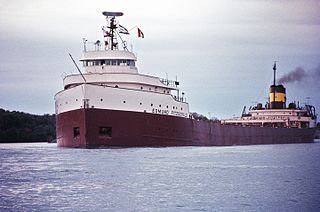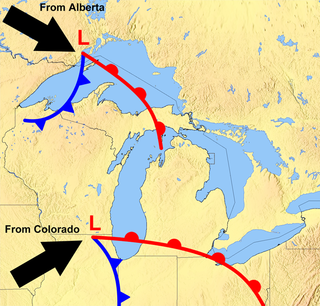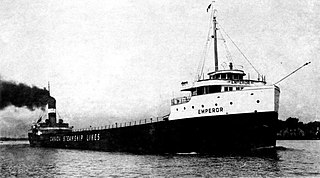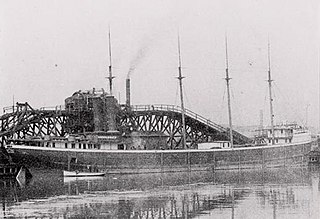Related Research Articles

SS Edmund Fitzgerald was an American Great Lakes freighter that sank in Lake Superior during a storm on November 10, 1975, with the loss of the entire crew of 29 men. When launched on June 7, 1958, she was the largest ship on North America's Great Lakes, and she remains the largest to have sunk there.
The Pere Marquette Railway operated in the Great Lakes region of the United States and southern parts of Ontario in Canada. It had trackage in the states of Michigan, Ohio, Indiana and the Canadian province of Ontario. Its primary connections included Buffalo; Toledo; and Chicago. The company was named after Père Jacques Marquette S.J. (1637–1675), a French Jesuit missionary who founded Michigan's first European settlement, Sault Ste Marie.

The Great Lakes Storm of 1913, historically referred to as the "Big Blow," the "Freshwater Fury," or the "White Hurricane," was a blizzard with hurricane-force winds that devastated the Great Lakes Basin in the Midwestern United States and Ontario, Canada from November 7 through November 10, 1913. The storm was most powerful on November 9, battering and overturning ships on four of the five Great Lakes, particularly Lake Huron. Deceptive lulls in the storm and the slow pace of weather reports contributed to the storm's destructiveness.

SS Carl D. Bradley was a self-unloading Great Lakes freighter that sank in a Lake Michigan storm on November 18, 1958. Of the 35 crew members, 33 died in the sinking. 23 were from the port town of Rogers City, Michigan. Her sinking was likely caused by structural failure from the brittle steel used in her construction.
The SS Anna C. Minch was a cargo carrier which foundered, broke in two, and sank in Lake Michigan during the Armistice Day Blizzard on 11 November 1940. The Anna C. Minch was a steam-powered, steel-hulled bulk freighter constructed in 1903 by the American Ship Building Company at Cleveland, Ohio.

The James B. Colgate was a whaleback steamer that sank off the shores of Long Point in Lake Erie on Friday, October 20, 1916. This day was dubbed "Black Friday" because of its fierce winds and towering waves wreaking havoc on numerous vessels traveling on Lake Erie’s waters. The Colgate, loaded with coal, left on its final voyage from Buffalo, heading for Fort William, today known as Thunder Bay. The vessel weighed 1,713 tons and measured 302 feet in length. Captain Walter Grashaw was the only surviving member of the 26-man crew.

The SS Regina was a steel canaler built for the Merchant Mutual Line and home ported in Montreal, Quebec. Named after Regina, Saskatchewan, Regina had a tonnage of 1,956 gross register tons (GRT) and a crew of 32.

The Emperor was a freighter built in 1910; it sank off the shore of Isle Royale in Lake Superior in 1947 and the remains are still on the lake bottom. The wreck was placed on the National Register of Historic Places in 1984.

The SS Kaliyuga was a steamship that sank with the loss of 16 lives on Lake Huron on the night of October 19/20, 1905. The wreck of the Kaliyuga has never been found, and the cause of her sinking remains a mystery.

The SS Erie L. Hackley was a passenger and cargo ship that operated in Lake Michigan from 1882 to 1903. The ship sank in a storm near Green Island on 3 October 1903.

The SS Marquette & Bessemer No. 2 was a train ferry that sank with the loss of between 30 and 38 lives on Lake Erie on December 8, 1909.

SS Clifton, originally Samuel Mather, was a whaleback lake freighter built in 1892 for service on the Great Lakes. She was 308 foot (94 m) long, 30 foot (9.1 m) beam, and 24 foot (7.3 m) depth, and had a 3,500 ton capacity. The self-propelled barge was built by the American Steel Barge Company in West Superior, Wisconsin. Her builders used a design well-suited to carry iron ore, her intended trade. The new vessel was christened Samuel Mather, after a cofounder of Pickands Mather and Company, which at the time was the second largest fleet on the Great Lakes.

Atlantic was a steamboat that sank on Lake Erie after a collision with the steamer Ogdensburg on 20 August 1852, with the loss of at least 150 but perhaps as many as 300 lives. The loss of life made this disaster, in terms of loss of life from the sinking of a single vessel, the fifth-worst tragedy in the history of the Great Lakes.

SS Amasa Stone was a 545-foot (166 m) Great Lakes freighter that was sunk as a breakwater in 1965, Charlevoix, Michigan. She was built for the Mesaba Steamship Company by the Detroit Shipbuilding Company of Wyandotte, Michigan. She was launched on March 25, 1905 as hull #158. She was powered by an 1,800-horsepower (1,300 kW) triple expansion steam engine and two scotch marine boilers.

SS Choctaw was an American semi-whaleback freighter in service between 1892 and 1915. She was a monitor vessel containing elements from both traditional lake freighters and the whaleback ships designed by Alexander McDougall. Choctaw was built in 1892 by the Cleveland Shipbuilding Company in Cleveland, Ohio. Originally owned by the Lake Superior Iron Company, she was sold to the Cleveland-Cliffs Iron Company in 1894, the firm for which she would spend the rest of her career working for.

SS Hudson was a steel-hulled package freighter that served on the Great Lakes from her construction in 1887 to her sinking in 1901. On September 16, 1901, while heading across Lake Superior with a cargo of wheat and flax, she ran into a storm and sank with the loss of all 25 crew off Eagle Harbor, Michigan. For nearly 118 years the location of Hudson's wreck remained unknown, until in July 2019 her wreck was found in 825 feet (251 m) of water, completely intact.

SS S.R. Kirby was a composite-hulled bulk carrier that served on the Great Lakes of North America from her construction in 1890 to her sinking in 1916. On May 8, 1916, while heading across Lake Superior with a cargo of iron ore and the steel barge George E. Hartnell in tow, she ran into a storm and sank with the loss of all but two of her 22-man crew off Eagle Harbor, Michigan. For over 102 years the location of S.R. Kirby's wreck remained unknown, until June 2018, when her wreck was discovered by the Great Lakes Shipwreck Historical Society (GLSHS) in 825 feet (251 m) of water, completely broken up.

SS Russia was an iron-hulled American Great Lakes package freighter that sank in a Lake Huron gale on April 30, 1909, near DeTour Village, Michigan, with all 22 of her crew and one passenger surviving.
References
- 1 2 3 "Storm sank 4 ships on Lake Erie in 1916 - The Blade". toledoblade.com. Retrieved 2016-12-28.
- 1 2 3 4 5 6 "Today marks 100th anniversary of 'Black Friday,' Lake Erie's perfect storm | MLive.com". mlive.com. Retrieved 2016-12-28.
- 1 2 "Lake Erie Winds: The Real Black Friday". lakeeriewinds.blogspot.com. Retrieved 2016-12-28.